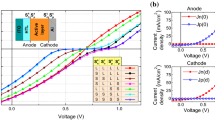Abstract
In this paper, three different numerical approaches were used for solving the steady-state drift–diffusion model (DDM) of organic solar cells. In order to simplify the standard DDM, the electron and hole continuity equations were decoupled by assuming a recombination rate for each type of carriers proportional to its concentration squared and a constant electric field throughout a device. The surface recombination and thermionic emission of electrons and holes on both electrode contacts were considered through Robin-type boundary conditions. The most often used numerical solution based on the finite difference method with Schaffeter-Gummel discretization (FDMSG) showed significant instabilities when certain surface recombination velocities (SRVs) were reduced. Trying to avoid instabilities, a Discontinuous Galerkin method with Lax-Friedricks numerical flux (DGLF) was proposed. The DGLF calculations turned out to be even more unstable than the FDMSG ones. To improve the developed Discontinuous Galerkin scheme, the Schaffeter-Gummel numerical flux was implemented (DGSG). A significant progress in the calculation stability has been achieved for a wide range of SRVs. Using each of the considered numerical models, the intervals of SRVs for which the electrode contacts act as (1) ideally blocking, (2) neither blocking nor conductive, or (3) ideally conductive, were defined for holes and electrons. The SRV ranges in which the calculation instabilities occur were determined for each numerical approach. The current density–voltage (J–V) characteristics simulated by the DDM and solved with the DGSG method were compared to a measured ITO/PEDOT:PSS/P3HT:PCBM/Al solar cells J–V curve for model validation.




Similar content being viewed by others
References
Chen, L., Bagci, H.: Steady-State Simulation of Semiconductor Devices Using Discontinuous Galerkin Methods. IEEE Access, 16203–16215, (2020), https://doi.org/10.1109/ACCESS.2020.2967125
Ćirović, N., Khalf, A., Gojanović, J., Matavulj, P.,Živanović, S.: Current-voltage characteristics simulations of organic solar cells using discontinuous Galerkin method. In: 2021 International Conference on Numerical Simulation of Optoelectronic Devices (NUSOD), 13–17. Sept. (2021), https://doi.org/10.1109/NUSOD52207.2021.9541418
Farrell, P., Rotundo, N., Doan, D., Kantner, M., Fuhrmann, J., Koprucki, T.: Numerical methods for drift-diffusion models. In: J. Piprek, Ed. Handbook of optoelectronic device modeling and simulation: Lasers, modulators, photodetectors, solar cells, and numerical methods, vol. 2. CRC Press, Boca Raton (2017)
Goshekar, C., Patil, C.: Review on performance analysis of P3HT:PCBM-based bulk heterojunction organic solar cells. Semiconductor Sci. Technol. 36, 045005 (1–15), (2021), https://doi.org/10.1088/1361-6641/abe21b
Hesthaven, J.S., Warburton, T.: Nodal Discontinuous Galerkin Methods: Algorithms, Analysis, and Applications. Springer Verlag, New York (2008)
Jelić, Ž., Petrović, J. Matavulj, P., Melancon, J., Sharma, A., Zellhofer, C., Živanović, S.: Modeling of the polymer solar cell with P3HT:PCBM active layer. Physica Scripta T162, 014035 (1–4), (2014), https://doi.org/10.1088/0031-8949/2014/T162/014035
Khalf, A., Gojanović, J., Ćirović, N., Živanović, S.:Two different types of S‑shaped J‑V characteristics in organic solar cells. Opticaland Quantum Electronics 52, 121(1–10), (January2020), https://doi.org/10.1007/s11082-020-2236-7
Khalf, A., Gojanović, J., Ćirović, N., Živanović, S., Matavulj, P.: The Impact of Surface Processes on the J-V Characteristics of Organic Solar Cells. IEEE J. Photovoltaics 10, 514–521 (2020). https://doi.org/10.1109/JPHOTOV.2020.2965401
Koster, L. J. A., Smits, E. C. P., Mihailetchi, V. D., Blom, P. W. M.: Device model for the operation of polymer/fullerene bulk heterojunction solar cells. Phys. Rev. B 72, 085205 (1–9), (2005), https://doi.org/10.1103/PhysRevB.72.085205
Kumar N.: Flux approximation schemes for flow problems using local boundary value problems. Eindhoven: Technische Universiteit Eindhoven, 126 p. ISBN 978-90-386-4391-5 (2017)
Sandberg, O., Nyman, M., Österbacka, R.: Effect of contacts in organic bulk heterojunction solar cells. Phys. Rev. Appl. 1, 024003 (2014). https://doi.org/10.1103/PhysRevApplied.1.024003
Sandberg, O., Nyman, M., Österbacka, R.: Determination of surface recombination velocities at contacts in organic semiconductor devices using injected carrier reservoirs. Phys. Rev. Lett. 118, 076601 (2017). https://doi.org/10.1103/PhysRevLett.118.076601
Scharfetter, D., Gummel, H.: Large-signal analysis of a silicon Read diode oscillator. IEEE Trans. Electron. Dev. ED 16, 64–77, (1969), https://doi.org/10.1109/T-ED.1969.16566
Schroeder,D.: Modelling of Interface Carrier Transport for Device Simulation. Springer-Verlag Wien, Berlin (1994)
Sievers, D., Shrotriya, V., Yang, Y.: Modeling optical effects and thickness dependent current in polymer bulk-heterojunction solar cells. J. Appl. Phys. 100, 114509 (1–7), (2006). https://doi.org/10.1063/1.2388854
Van Roosbroeck, W.: Theory of the flow of electrons and holes in Germanium and other semiconductors. Bell Syst. Techn. J. 29, 560–607 (1950). https://doi.org/10.1002/j.1538-7305.1950.tb03653.x
Zhang, M., Zhu, L., Zhou, G., Hao T., Qiu, C, Zhao, Z., Hu, Q., Larson B.W, Zhu, H., Ma, Z., Tang, Z., Feng, W., Zhang, Y., Russell, T.P., Liu, F.: Single-layered organic photovoltaics with double cascading charge transport pathways: 18% efficiencies. Nat. Commun. 12, 309 (1–10) (2021). https://doi.org/10.1038/s41467-020-20580-8
Acknowledgements
This work is partially supported by the Serbian Ministry of Education, Science and Technological Development under contract No. 62101.
Funding
All authors certify that they have no affiliations with or involvement in any organization or entity with any financial interest or non-financial interest in the subject matter or materials discussed in this manuscript.
Author information
Authors and Affiliations
Corresponding author
Additional information
Publisher's Note
Springer Nature remains neutral with regard to jurisdictional claims in published maps and institutional affiliations.
This article is part of the Topical Collection on Numerical Simulation of Optoelectronic Devices, Guest edited by Slawek Sujecki, Asghar Asgari, Donati Silvano, Karin Hinzer, Weida Hu, Piotr Martyniuk, Alex Walker and Pengyan Wen.
Rights and permissions
About this article
Cite this article
Ćirović, N., Khalf, A., Gojanović, J. et al. Comparing three numerical methods for current–voltage characteristics simulations of organic solar cells considering surface recombination effects. Opt Quant Electron 54, 335 (2022). https://doi.org/10.1007/s11082-022-03745-1
Received:
Accepted:
Published:
DOI: https://doi.org/10.1007/s11082-022-03745-1




